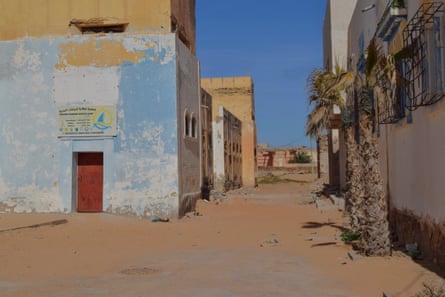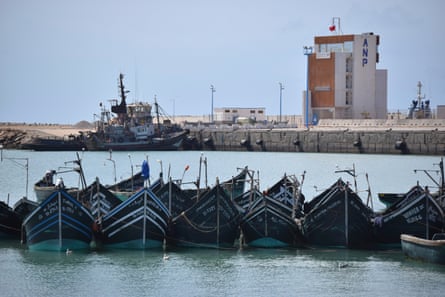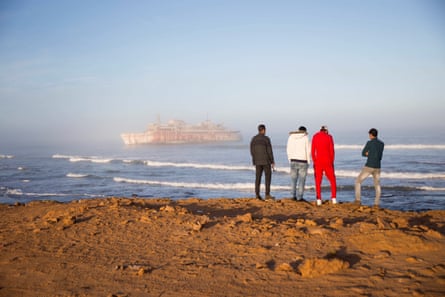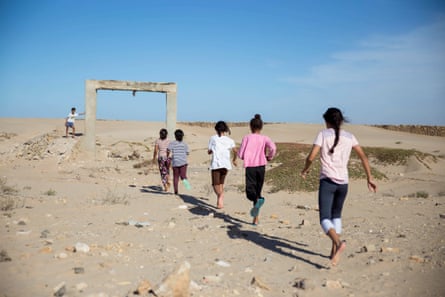The Canary Islands are so close that, on a clear night, surfing instructor Salim Maatoug can see the lights across the water. Fourteen million tourists a year flock to the Spanish archipelago, while in the Moroccan fishing port where Maatoug lives, sand from the Sahara drifts in the streets.
“In the Canaries you can hardly surf because it’s so crowded,” he says. “Here in Tarfaya we have 300km [200 miles] of waves.”
Maatoug learned to surf in 2004, from foreigners who drive down the African coast. He eventually started running free classes for local children. Now he is working to set up a regional surf club in Tarfaya, which he hopes will attract visitors and employ 30 former pupils.
“This will help the young people not to emigrate to Spain in pateras,” he says, referring to fishing boats co-opted to transport undocumented migrants. “Tourists will migrate to Tarfaya.”
But the 80-mile strait between Tarfaya and the Canary Islands is treacherous. Wrecks have included not only countless pateras but one commercial ferry operated by the Spanish company Naviera Armas, which ran aground in 2008 after just five months in operation. The rusted wreck still looms off Tarfaya’s coast. The line was never reopened.
“The economy had just started to grow – and then, nothing,” says Mohamed Salem Behiya, the president of Tarfaya provincial council. “The key for us to progress is the maritime line.”
During Behiya’s eight-year presidency, attempts to reopen the line have come to nothing. He is so passionate about the project, he once rented a ferry and applied to operate it himself. But the government wanted competing bids, and nobody else applied.
Now there’s another chance. Ángel Víctor Torres, the president of the Canary Islands, this month visited the Moroccan capital, Rabat, where both governments discussed the line’s commercial benefits. Torres stressed the project could be subsidised if necessary.

“In other years this was unthinkable because relations were complicated,” he said.
Torres was alluding to the political rapprochement that has taken place since March 2022, when Spain backed Morocco’s “autonomy plan” for Western Sahara – a former Spanish colony disputed between Morocco and indigenous Sahrawis, who want an independent state. Morocco then clamped down on undocumented migration to Spain, largely of refugees from the Sahel. From February 2022 to 2023, irregular migration to the Canary Islands dropped by 60%.
Tarfaya is at the crossroads of these dynamics, just 20 miles north of the Western Sahara border. Its desolate coastline is peppered with military surveillance posts, watching for migrant boats. In 1975, 350,000 unarmed Moroccans marched from Tarfaya to claim the territory from the departing Spaniards, sparking a decades-long conflict with Sahrawi nationalists.
But Tarfaya has a convivial atmosphere, where people share tea and watch football in the cafes of the one main street and express hopes for reconnection with the Spanish archipelago.

“I want everything good for Tarfaya,” says Ahmed, a Sahrawi fisher. “I want 10 boats to come.”
Ahmed earns most of his living during octopus season, when he spends up to five days at a time at sea in his wooden patera. On 30 April 2008, he was fishing near Tarfaya when he saw the departing Armas ferry founder. “We knew it had a problem,” he says. “We went after it, until it ran aground.”
Tarfaya’s fishers undertook the rescue until emergency services arrived. “They heard, ‘The boat has a problem, it’s full of people, we have to help!’, and everyone went,” Ahmed says. “The boat had a little door up high. The people came down to the pateras with a wooden ladder.”
Ahmed carried three boatloads of passengers to safety. There were no casualties. He and several other fishers were later hired to do salvage work on the wreck. He claims contractors stripped the boat of valuables then left, failing to pay the fishers for two months’ work.
after newsletter promotion

The accident led to lasting recriminations. Passengers took cases to Spain’s supreme court. It ruled that damage to the ship had occurred when it left Tarfaya’s port, and that the crew had acted “impeccably” by running it aground to avoid sinking at sea.
But this ruling never convinced local people in Tarfaya, who suspect negligence. For many, the 15-year failure to clean up the wreck adds insult to injury.
“It’s a catastrophe to have that wreck there,” says Sadat Shaibata Mrabih Rabou, the director of the local museum, which is dedicated to the French author and aviator Antoine de Saint-Exupéry, who lived in Tarfaya in the 1920s. “We suffered to get any other [shipping] company to run this licence. Everybody sees the wreck and gets frightened.”
The port of Tarfaya has been renovated and the government has promised to remove the wreck, fearing environmental damage. But Tarfaya is still waiting for a ferry.
“Many people lost hope in that boat,” says Moulay Ali Atmani, a local cafe owner. “If you say you’ll open it today, and tomorrow, and the next day, businessmen won’t risk their money here.”
Atmani has not waited. Seven years ago, he started receiving Canarian tour groups via the nearest airport in Laâyoune. They stop at the notorious Armas wreck, which Atmani wants restored as an attraction. They camp in the dunes and see the ruined fort, a relic of when Tarfaya was part of Spanish Sahara before being captured by Morocco in 1958.
“In many groups we have people who were born in Spanish Tarfaya,” Atmani says. “Tarfaya has a lot of history to tell.”
The town’s historic buildings are slowly crumbling into sand or the sea. But Tarfaya is loved by its 8,000 residents, who – from the surf school and museum to electronics workshops and TEDx events – have various initiatives. Most have high hopes for the ferry, but don’t want development at any cost.
“It’s good as a key, an opening. But we don’t want mass tourism,” says Shaibata. “We have a very fragile, historic town, with a soul. Apparently there is nothing. But really there is everything.”


